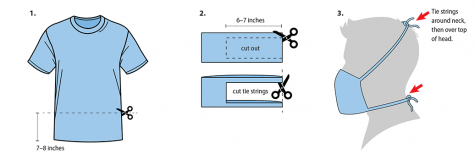The Best Materials for DIY Masks, According to Science
April 10, 2020
After recent suggestions from The Centers for Disease Control (CDC) that all people utilize universal mask-wearing while in public, many ideas have circulated regarding the best way to create a “DIY” mask.
Materials such as bandanas, t-shirts, pillowcases, vacuum filters, and coffee filters have been used to create these at home masks.
In a recently published article from the CDC, there are tutorials to three effective DIY masks, one that requires sewing and two others using a no-sew method.
The “Sewn Cloth Face Covering” requires cotton fabric, elastic ties, needle and thread, scissors, and a sewing machine. Two no-sew methods are also provided, one requiring a t-shirt and the other a bandana and a coffee filter.

For those who are infected by coronavirus, wearing any type of mask can reduce the spread through coughing, sneezing, or talking.
Though, according to The New York Times, “experts say there is more variation in how much homemade masks might protect the wearer from incoming germs, depending on the fit and quality of the material used.”
According to the article, recent studies conducted by High-Efficiency Particulate Air (HEPA), furnace filters, vacuum cleaner bags, pillowcases, and flannel fabrics were among the best materials from prohibiting bacteria particles from entering. Stacked coffee filters performed averagely in blocking particles, and materials such as scarves and bandanas scored the lowest but were still able to capture a small amount of bacteria particles.
If you do not have any of the recommended materials at home, you can determine whether or not a material is suitable by performing a light test. According to Dr. Scott Segal, chairman of anesthesiology at Wake Forest Baptist Health, “Hold it up to a bright light. If light passes really easily through the fibers and you can almost see the fibers, it’s not a good fabric.”
While many materials prove to effectively block particles from entering, they are unwearable due to the denseness. Although these materials would be the most effective, it is more important you are able to breathe efficiently while wearing the mask.
In a video posted by Jiangmei Wu, professor of interior design at Indiana University, a simple tutorial for an origami folded mask using a vacuum bag is provided, beneficial for those who are unable to sew.
According to tests performed at Missouri University and The University of Virginia, vacuum bags effectively removed between 60 and 87 percent of particles.
It is important to remember that while masks can slow the spread of the coronavirus, they will not completely prevent it, and to continue maintaining social distancing when possible.


